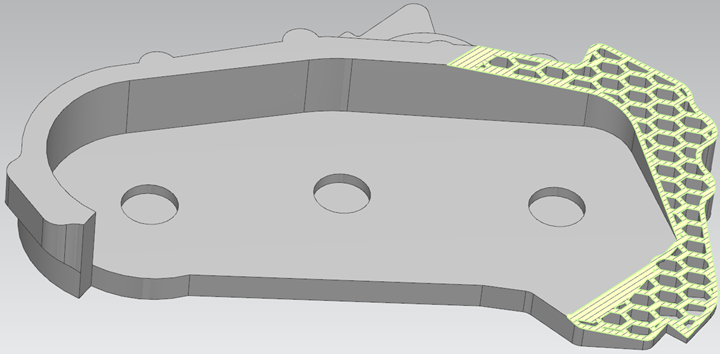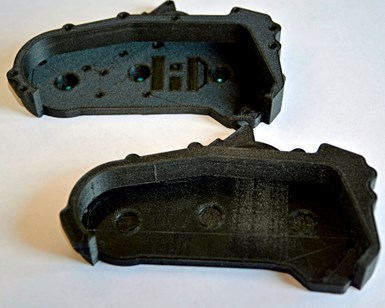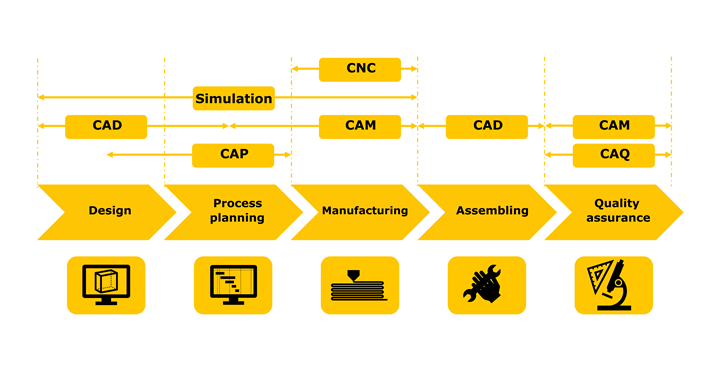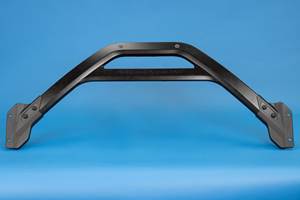AIM3D, Naddcon implement digital process chain for 3D printing
The ExAM 255 multi-material 3D printer from AIM3D, integrated into Siemens’ NX design software, opens up new optimization possibilities for 3D-printed designs, demoed by a 3D-printed GFRP component.
The optimized component made of glass fiber-reinforced polyamide is represented here within the NX program with a weight-optimized lattice structure. Photo Credit, all images: Naddcon
AIM3D GmbH (Rostock, Germany), in cooperation with Naddcon GmbH’s (Lichtenfels, Germany) research and development center, an additive manufacturing (AM) specialist, recently integrated an ExAM 255 3D printer from AIM3D with Siemens Digital Industries Software’s (Plano, Texas, U.S.) NX design software. The NX tool contains extensive CAD, CAM and CAE solutions, as already used for the conventional manufacturing of components in the machining industry. Naddcon integrated the software with AIM3D’s multi-material 3D printer in an effort to enable mapping the 3D printing process as a continuous digital process chain, from the component design to production and post-processing. For example, users can now make use of an alternative approach to operate 3D printers and to generate G-code.
The bridge between AIM3D’s machine firmware and Siemens NX’s CAD/CAM environment is reported to integrate the 3D printer into a CAM processing machine. With CAD, CAM and CAE approaches, NX offers the user a comprehensive tool for the design and iterative optimization of additive components. Based on a desired requirement profile, 3D components can be optimized in terms of bionics, free-form surfaces, selective densities (variable filling strategies) and weight reductions (for example, grid structures).
Composite 3D-printed demonstrator component. Original design (top) and NX-optimized design (bottom).
In addition, fiber reinforcement can be laid down in an optimized manner with respect to the force flow, which defines the stiffness or elasticity and the mechanical load capacity. A database system and simulation models are also available, meaning that the entire 3D printing process — from design to production — can be better controlled, components can be optimally designed and a high level of reproducibility can be achieved.
It is said that NX enables an exact machine simulation. More precisely, this means that traversing speeds, extruder performance and temperatures can be controlled with pinpoint accuracy depending on the component geometry, according to AIM3D and Naddcon.
Using the NX design software, Naddcon notes that generation of tool paths along curved surfaces is possible, ensuring that true 3D paths, which create planes independently, can be generated during the composite extrusion modeling (CEM) process inherent to AIM3D’s 3D printers. Moreover, using this technology in process development can eliminate the staircase effect typical of AM processes. The result is a true 3D contour of a solid body.
Sebastian Kallenberg, project engineer at Naddcon, demonstrated the capabilities behind this system integration via a standardized demonstrator component made of glass fiber-reinforced polyamide (PA6 GF30), the design of which was to be optimized using NX.
First, Kallenberg built a kinematic model of the 3D printer by integrating the CAD model of the ExAM 255 into NX, as well as defining the kinematic axes and determining the machine zero point. The kinematic model enables a machine simulation of the tool paths before the actual production process takes place. The next step was the generation of the tool path for the extruder of the AM system. This involves generating trajectories based on machining operations and the component geometry. Third was the machine simulation of the ExAM 255 — that is, the simulation of the tool path with the associated axis movements of the machine model. The application of the material, as well as potential machine collisions, can also be simulated. The main aspect here is the programming of a post-processor to translate the NX tool paths into a numerical G-code that the 3D printer can interpret.
A G-code consists of path conditions (G-word) and additional functions (M-word), each of which are assigned either a movement or an action. The combination of these commands allows the 3D printer to understand the pattern it must follow to produce the part. In 3D printing, a G-code is usually generated automatically by the slicer software when the design is converted to an STL file. Post-processor programming enable machine-specific adjustments for an improved process control. When using NX, however, an STL format is no longer necessary, as the process makes use of solids that are either directly generated within NX or can be imported from a different CAD system.
To develop the sample component, the tool path was generated, and tests were carried out on the ExAM 255 machine to identify the optimal process parameters, but also possible errors in the post-processor. For an optimized design, NX enables the user to vary densities, integrate lattice structures to reduce weight, control shrinkage, apply stiffeners and move “drill holes.”
“Our digital NX approach is intended to better exploit the CEM machine technology from a design and production preparation point of view,” Kallenberg says. “There is considerable potential here for free-form surfaces, that is, real 3D contours, but also bionic design strategies.”
Learn more about the potential of composite extrusion modeling (CEM), or have AIM3D’s 3D printers target precise, cost-effective polymer processing
Related Content
Multi-material steel/composite leaf spring targets lightweight, high-volume applications
Rassini International was challenged by Ford Motor Co. to take weight out of the F-150 pickup truck. Rassini responded with a multi-material steel/composite hybrid leaf spring system that can be manufactured at high volumes.
Read MoreCirculinQ: Glass fiber, recycled plastic turn paving into climate solutions
Durable, modular paving system from recycled composite filters, collects, infiltrates stormwater to reduce flooding and recharge local aquifers.
Read MoreComposites manufacturing for general aviation aircraft
General aviation, certified and experimental, has increasingly embraced composites over the decades, a path further driven by leveraged innovation in materials and processes and the evolving AAM market.
Read MoreAutomotive chassis components lighten up with composites
Composite and hybrid components reduce mass, increase functionality on electric and conventional passenger vehicles.
Read MoreRead Next
CW’s 2024 Top Shops survey offers new approach to benchmarking
Respondents that complete the survey by April 30, 2024, have the chance to be recognized as an honoree.
Read MoreComposites end markets: Energy (2024)
Composites are used widely in oil/gas, wind and other renewable energy applications. Despite market challenges, growth potential and innovation for composites continue.
Read MoreFrom the CW Archives: The tale of the thermoplastic cryotank
In 2006, guest columnist Bob Hartunian related the story of his efforts two decades prior, while at McDonnell Douglas, to develop a thermoplastic composite crytank for hydrogen storage. He learned a lot of lessons.
Read More




















.jpg;maxWidth=300;quality=90)







